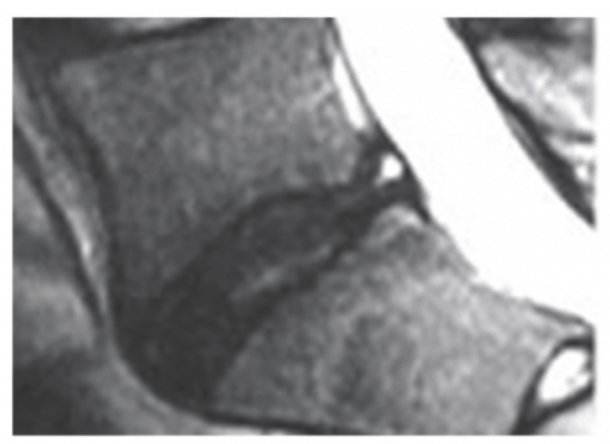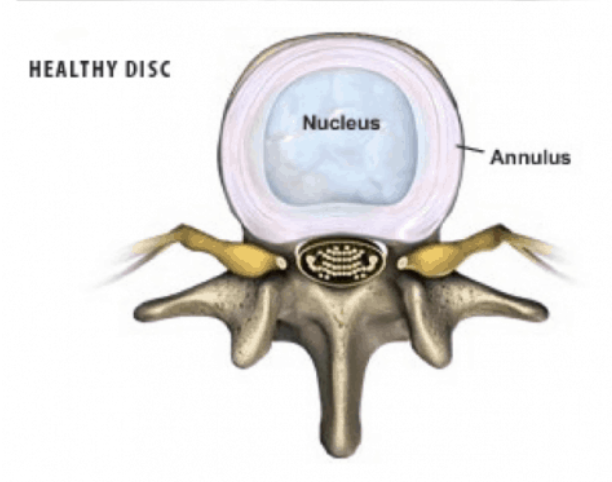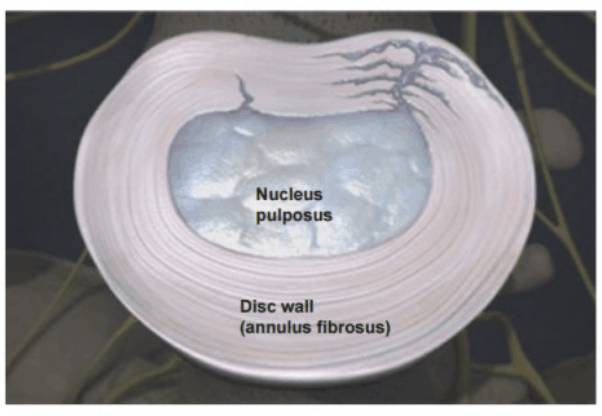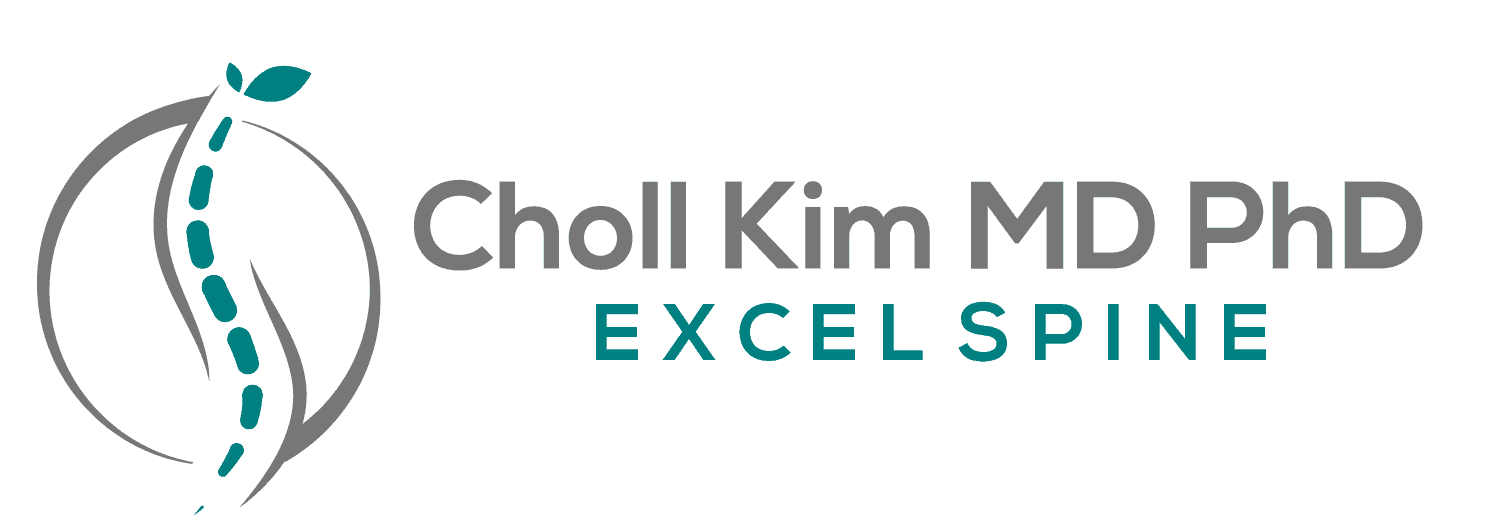The spine is made up of individual bones called vertebrae, which are separated by rubbery cushions called discs. They are stacked atop one another from the pelvis to the base of the skull. The discs act as shock absorbers to minimize the impact of movement. They support upper-body weight and muscle activity allowing for motion such as bending and flexing. A disc is like a jelly donut, with a soft center called the nucleus pulposus, encased within a tough exterior called the annulus fibrosus. The annulus is like an onion, made up of several layers, which contain the nucleus and distribute pressure evenly across the disc.
What Is an Annular Tear?
An annular tear is an injury to the tough outer layer of a spinal disc, known as the annulus fibrosus. Just like other ligaments in the body, this outer ring of the disc can tear or rupture due to stress or trauma. If the tear occurs but no disc material (nucleus pulposus) pushes through the tear, it is called an annular tear.
The outer third of the annulus fibrosus is rich in nerve fibers, making it very sensitive to pain. When this area is torn, it can cause significant discomfort, especially in the lower back. While the tear can heal over time with scar tissue, the area remains more vulnerable to future injury or re-tearing.
What Are the Causes of an Annular Tear?
Annular tears can result from both natural wear and traumatic injury. The most common cause is the natural aging process, which leads to disc dehydration and weakening of the disc structure over time. However, they can also occur suddenly from high-impact incidents such as car accidents, falls, heavy lifting, or sports-related injuries. Repetitive strain or poor body mechanics can also contribute to the development of tears over time.



What Are the Signs and Symptoms of an Annular Tear?
Patients with an annular tear often report central low back pain that is worse than any pain radiating into the legs. The pain tends to be more pronounced while sitting and may improve slightly when standing or lying down. Activities that increase pressure in the spine—such as coughing, sneezing, bending forward, or lifting heavy objects—can intensify symptoms.
Other signs may include:
- Numbness or tingling
- Loss of sensation in the legs
- Decreased strength in the lower extremities
What Are the Risk Factors of an Annular Tear?
Risk factors that may increase the likelihood of developing an annular tear include:
- Aging and disc degeneration
- Heavy lifting or repetitive spinal stress
- Trauma or high-impact accidents
- Smoking, which reduces disc nutrition and healing capacity
- Poor posture or improper lifting technique
- Obesity, which increases mechanical stress on the spine
- Sedentary lifestyle and lack of core strength
How Is an Annular Tear Diagnosed?
Diagnosis typically begins with a physical examination and a review of the patient’s symptoms and medical history. If an annular tear is suspected, advanced imaging such as MRI is the most useful diagnostic tool. On MRI, annular tears often appear as small, bright zones in the outer layer of the disc (sometimes called a “high-intensity zone”).
In some cases, a discogram—a specialized diagnostic test involving contrast dye—is used to confirm the presence of a tear and identify if the disc is the actual source of pain.
What Are the Treatment Options for an Annular Tear?
Most annular tears can be treated conservatively without surgery. Common treatment options include:
Non-Surgical Treatments:
- Physical therapy focused on strengthening core muscles, improving flexibility, and correcting posture
- Anti-inflammatory medications like NSAIDs to reduce pain and inflammation
- Epidural steroid injections to calm irritated nerves and provide temporary relief and to provide diagnostic information to help determine if the tear is responsible for the pain
- Activity modification, including avoiding heavy lifting and prolonged sitting
- Chiropractic care, massage therapy, or acupuncture as complementary options
Surgical Treatment:
Surgery is rarely needed for isolated annular tears unless they lead to significant disc herniation, nerve compression, or persistent pain that does not respond to conservative care. When surgery is necessary, options may include a laser endoscopic discectomy.
Can an Annular Tear Be Prevented?
While not all annular tears can be prevented, there are steps that can reduce your risk:
- Maintain good posture, especially when sitting or lifting
- Practice proper body mechanics when moving heavy objects
- Stay physically active with exercises that strengthen the core and support the spine
- Avoid smoking, as it interferes with disc health and healing
- Maintain a healthy weight to reduce stress on the spine
- Use supportive ergonomic furniture, particularly if you sit for long periods
What Happens If an Annular Tear Is Left Untreated?
If left untreated, an annular tear may continue to cause pain or may worsen over time, potentially leading to a disc herniation if the inner disc material pushes through the tear. Prolonged inflammation can also irritate nearby nerves, resulting in chronic back pain or radiculopathy (radiating nerve pain). Addressing symptoms early can help prevent complications and preserve spinal function.
Are There Other Conditions Related to an Annular Tear?
Annular tears may occur alongside or lead to other spinal conditions, such as:
- Disc herniation
- Degenerative disc disease
- Spinal stenosis
- Sciatica
- Facet joint syndrome
A thorough evaluation by a spine specialist can help identify whether an annular tear is the primary issue or part of a more complex spinal condition.
Key Takeaways About an Annular Tear
- An annular tear is a small tear in the outer layer of a spinal disc.
- It is often caused by aging, repetitive strain, or traumatic injury.
- Symptoms commonly include central low back pain, especially with sitting or bending.
- Most cases can be managed without surgery through physical therapy, medications, and activity modification.
- Preventative measures such as proper posture, regular exercise, and a healthy lifestyle can lower your risk.
- Early diagnosis and treatment help reduce the chance of progression and improve quality of life.
Recommended Next Steps
If you’re experiencing persistent low back pain—especially pain that worsens with sitting, bending, or lifting—it may be time to speak with a healthcare provider or spine specialist. They can help determine the cause of your symptoms and recommend appropriate next steps. Early diagnosis, conservative treatment, and lifestyle adjustments can make a significant difference in managing pain and protecting your spine long-term.

